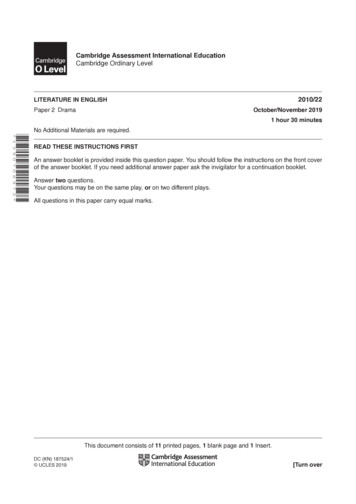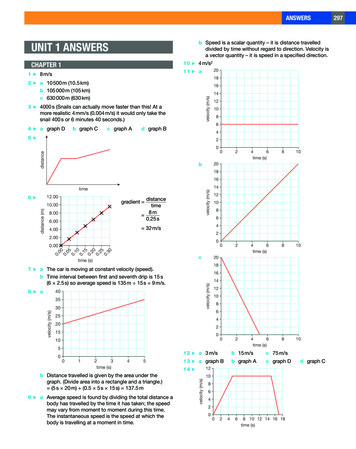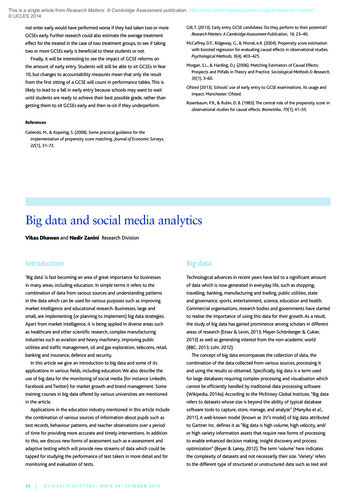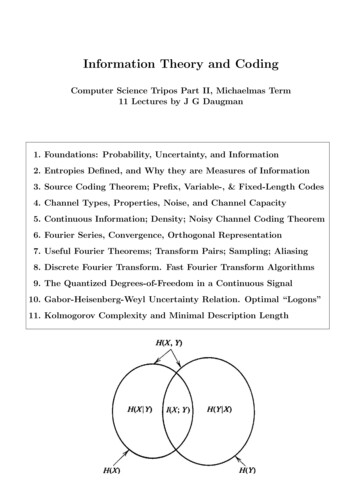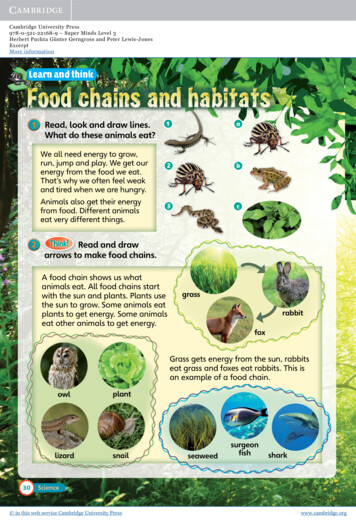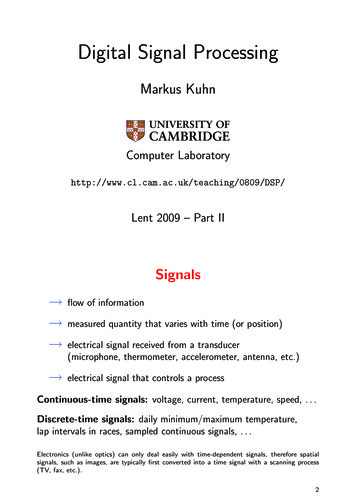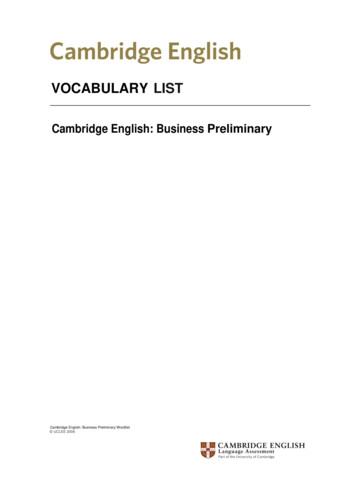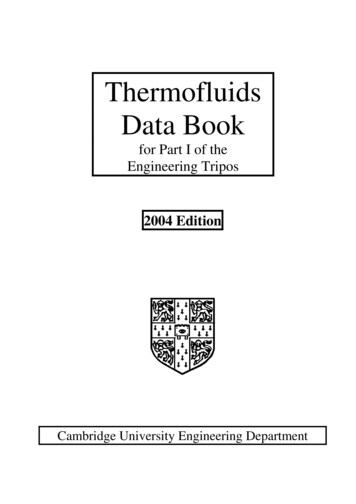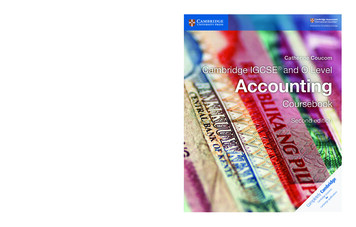
Transcription
Key features: A range of new practice exercises builds students’ accounting skillsand confidence with the subject Walkthroughs illustrate key accounting principles with absolute clarity Key terms highlight and explain important concepts, helping studentsproduce clear and accurate answers Test yourself questions reinforce learning and aid self-assessment Revision checklists provide a quick summary of the key points coveredin a chapter to consolidate learningOther components in this series:Workbook:Revision Guide:Teacher’s Resource:Coursebook Elevate enhanced 8-44057-8978-1-108-43901-5Completely CambridgeCambridge University Press works with Cambridge AssessmentInternational Education and experienced authors, to producehigh-quality endorsed textbooks and digital resources that supportCambridge Teachers and encourage CambridgeLearners worldwide.To find out more about Cambridge University Press visitcambridge.org/cambridgeinternationalThis resource is endorsed byCambridge Assessment International Education Supports the full Cambridge IGCSE andO Level Accounting syllabuses(0452/7707) for examination from 2020 Has passed Cambridge International’srigorous quality-assurance process Developed by subject experts For Cambridge schools worldwideCoucom9781316502778 Coucom: Cambridge IGCSEand O Level Accounting Coursebook Cover C M Y KWith more practice questions than the previous edition and contentmatched to the Cambridge IGCSE and O Level Accounting syllabuses, thiscoursebook increases understanding of accounting best practice. Clearstep-by-step explanations and instructions help students learn how torecord, report, present and interpret financial information while gaining anappreciation of the ways accounting is used in modern business contexts.The coursebook is ideal for those new to accounting. Also available inthe series – workbook, revision guide, teacher’s resource and CambridgeElevate enhanced edition. Answers to the coursebook and workbookquestions are in the teacher’s resource.Cambridge IGCSE and O Level Accounting CoursebookCambridge IGCSE and O LevelAccountingCoursebookSecond editionCatherine CoucomCatherine CoucomCambridge IGCSE and O LevelAccountingCoursebookSecond edition
: ContentsIntroductionivWhere to find each section of the syllabusvHow to use this bookviAcknowledgementsiixSection 111Introduction to accounting22Double entry book-keeping – Part A103The trial balance294Double entry book-keeping – Part B385Petty cash books52Section 1: Practice questions61Section 2666Business documents677Books of prime entry78Section 2: Practice questions89Section 3938Financial statements – Part A949Financial statements – Part B11010 Accounting rules12011 Other payables and other receivables13212 Accounting for depreciation and disposal of non-current assets15313 Irrecoverable debts and provisions for doubtful debts171Section 3: Practice questions185Section 419314 Bank reconciliation statements19415 Journal entries and correction of errors20616 Control accounts22817 Incomplete records24118 Accounts of clubs and societies26119 Partnerships27720 Manufacturing accounts29021 Limited companies30222 Analysis and interpretation312Section 4: Practice questions331Glossary345Index349iii
94Chapter 8Financial statements – Part ALearning objectivesIn this chapter you will learn to: explain the advantages and disadvantages of operating as a sole trader 5.1explain the importance of preparing income statements 5.1explain the difference between a trading business and a service business 5.1prepare income statements for trading businesses and for service businesses 5.1make adjustments for goods taken by the owner for own use 5.1balance ledger accounts as required and make transfers to financial statements. 2.18
Chapter 8: Financial statements – Part AChapter 8Financial statements – Part A8.1 IntroductionAll the previous chapters have covered the book-keeping records maintained by a sole trader.Similar records will be maintained by other types of businesses.When a person is operating a business alone as a sole trader, he/she is entitled to all theprofits the business makes, but will be responsible for any losses the business makes.Business decisions may be made quickly, as consultation is not necessary, but there is noone with whom to share the decision-making or the workload. The capital of the business willbe restricted to what the trader is able to invest, whereas other forms of business have accessto capital invested by other owners of the business.When a person starts a business his/her aim is to make a profit. The profit (or loss) iscalculated in the financial statements which are usually prepared at the end of each financialyear. Financial statements basically consist of two parts:1 An income statement which consists of two sections: a trading section in which the gross profit of the business is calculated a profit and loss section in which the profit for the year of the business is calculated.The trading section and the profit and loss section of the income statement are part ofthe double entry system.LINKYou will learn aboutpartnerships andlimited companies inChapters 19 and 21.KEY TERMAn incomestatement is astatement preparedfor a trading period toshow the gross profitand profit for the year.2 A statement of financial position shows the assets and liabilities of the business at acertain date. The statement of financial position is not part of the double entry system.LINKFinancial statements are usually prepared from a trial balance. Every item in a trial balanceappears once in a set of financial statements. As each item is used, it is useful to place atick ( ) against the item. This ensures that no items are overlooked.You will learn moreabout statements offinancial position inChapter 9.It is common to find notes accompanying a trial balance about various adjustments whichare to be made (these are explained in the following chapters). Any notes to a trial balanceare used twice in a set of financial statements. To ensure that this is done, it is useful toplace a tick ( ) against the notes each time they are used.TIPEvery item in a trial balance is used once within a set of financial statements; any notes to a trialbalance are used twice within a set of financial statements.TIPTick off the items froma trial balance andthe notes to a trialbalance as you usethem so that nothingis omitted.95
Cambridge IGCSE and O Level AccountingWalkthrough 8.1The following trial balance was extracted from the books of Samir at 31 May 20–8.This trial balance will be used in Walkthrough 8.2 to Walkthrough 8.7.SamirTrial balance at 31 May 20–8Dr TIPThe term ‘revenue’ isused instead of ‘sales’in a trial balanceand in an incomestatement.RevenueSales returnsPurchasesCr 95 7001 00065 000Purchases returns500Carriage inwards1 500Inventory 1 Jun 20–87 100Discount receivedDiscount allowedWagesGeneral expenses9640090011 2002 800Property tax600Loan interest500Premises80 000Fixtures and equipment13 900Trade receivables7 500Trade payables7 800Bank3 300Cash100Long-term loan10 000Capital90 000Drawings209 000204 400204 400204 400 The inventory at 31 May 20–8 was valued at 7 600. During the year ended 31 May 20–8, Samir took goods costing 300 for his own use.No entries have been made in the accounting records.
Chapter 8: Financial statements – Part A8.2 Trading section of the income statementThe trading section is concerned with buying and selling, and its purpose is to calculatethe profit earned on the goods sold. This is known as the gross profit. The formula forcalculating gross profit is:Gross profit Selling price of goods – Cost of salesThe selling price represents the total sales less any sales returns.KEY TERMThe gross profit is thedifference between theselling price and thecost of those goods.The cost of sales represents the total cost of the goods actually sold. This is not necessarilythe cost of goods purchased during the year: some goods may have been in stock at the startof the year, and some of the goods purchased during the year may remain unsold at the endof the year. The formula for calculating cost of sales is:Cost of sales Opening inventory Purchases – Closing inventoryThe purchases figure represents the total cost of purchases less any purchases returns. Ifcarriage inwards has been paid on goods purchased this must be added to the purchases as itincreases the cost of the goods. If the owner of the business has withdrawn goods for personaluse the cost of these is credited to the purchases account, so reducing the cost of goodsavailable for sale. If goods taken by the owner have not already been recorded they must bededucted from the purchases. The formula for calculating the net purchases figure is:Net purchases Purchases – Purchases returns Carriage inwards – Goods for own useThe calculation of gross profit is shown in the trading section of the income statement. Thismust have a heading which includes the period of time covered by the statement. It is alsousual to include the name under which the business trades.TEST YOURSELF 8.11 State what is calculated in:a a trading account section of an income statementb a profit and loss account section of an income statement.2 State the formula for calculating gross profit.3 State the formula for calculating cost of sales.There are two ways in which a trading section of an income statement can be prepared –horizontal and vertical.The horizontal format is similar to a traditional ledger account. Using this method, therevenue is shown on the credit side and the cost of sales on the debit side. The difference(or balance) between the two sides equals the gross profit.97
Cambridge IGCSE and O Level AccountingWalkthrough 8.2Using the trial balance and accompanying notes shown in Walkthrough 8.1, prepare thetrading section of the income statement of Samir for the year ended 31 May 20–8. Use thehorizontal format.SamirIncome statement (trading section) for the year ended 31 May 20–8 Opening inventory 7 100 RevenuePurchases65 000Less Purchases returns94 500Less Sales returns 95 70091 000 94 70064 500Less Goods for own use94 30064 200Carriage inwards91 500 65 70072 800Less Closing inventory97 600Cost of sales65 200Gross profit c/d29 50094 70094 70094 70098 As these items are entered in the trading section of the income statement, they should beticked-off in the trial balance and accompanying notes. The gross profit is carried down to the profit and loss section (see Section 8.3). The first money column on each side has been used for adding and subtracting items andthe final column had been used for the section total.A trading section of an income statement can also be prepared using the vertical format.This is the format used by most businesses. A statement prepared using this method containsthe same information as a horizontal account, but looks like an arithmetic calculation.Walkthrough 8.3Using the trial balance and accompanying notes shown in Walkthrough 8.1, prepare thetrading section of the income statement of Samir for the year ended 31 May 20–8. Use thevertical format.
Chapter 8: Financial statements – Part ASamirIncome statement (Trading Section) for the year ended 31 May 20–8 RevenueLess Sales returnsLess Cost of salesOpening inventoryPurchasesLess Purchases returnsLess Goods for own useCarriage inwards 95 70061 00094 7007 10065 00061 50064 50061 30064 20061 500Less Closing inventoryGross profit65 70072 80067 60065 20029 500 The first two money columns have been used for adding and subtracting items and thefinal column for the final section total. For example, the first column has been used toadjust the purchases for returns, carriage and goods for own use and the final cost ofpurchases has been entered in the second column.99You can now answer Questions 1 and 2 at the end of this chapter.8.3 Profit and loss section of the income statementThe profit and loss section of an income statement is concerned with profits and losses,gains and expenses. Its purpose is to calculate the final profit after all running expenses andother items of income. This is known as the profit for the year. The formula for calculatingprofit for the year is:Profit for the year Gross profit Other income – ExpensesThe profit and loss section of an income statement must have a heading which includes theperiod of time covered by the statement. It is also usual to include the name under which thebusiness trades.As with a trading section of an income statement, a profit and loss section can be preparedusing either the horizontal or the vertical method. Using the horizontal format, the grossprofit and any other income are shown on the credit side and the expenses are shown on thedebit side. The difference (or balance) between the two sides equals the profit for the year(if the credit side is the largest) or the loss for the year (if the debit side is the largest).Walkthrough 8.4Using the trial balance and accompanying notes shown in Walkthrough 8.1, prepare theprofit and loss section of the income statement of Samir for the year ended 31 May 20–8.Use the horizontal format.KEY TERMThe profit for theyear is the final profitafter any other incomehas been added tothe gross profit andthe running expenseshave been deducted.
Cambridge IGCSE and O Level AccountingSamirIncome statement (profit and loss section) for the year ended 31 May 20–8 Discount allowedWages 900 Gross profit b/d29 50011 200 Discount receivedGeneral expenses2 800Property tax600Loan interest500Profit for the year40013 90029 90029 90029 900 As these items are entered in the profit and loss section of the income statement theyshould be ticked-off in the trial balance and accompanying notes. The gross profit is brought down from the trading section where it was calculated.A profit and loss section of an income statement can also be prepared using the verticalformat. This format is used by most businesses. A statement prepared using this methodcontains the same information but looks like an arithmetic calculation.Walkthrough 8.5100Using the trial balance and accompanying notes shown in Walkthrough 8.1, prepare theprofit and loss section of the income statement of Samir for the year ended 31 May 20–8.Use the vertical format.SamirIncome statement (profit and loss section) for the year ended 31 May 20–8 Gross profit29 500Add Discount received13 40029 900Less Discount allowedWagesGeneral expensesProperty tax90011 2002 80013 600Profit from operationsLess Loan interestProfit for the year15 50014 40013 50013 90013 900 Using the vertical presentation it is easy to show the profit earned from the normal tradingor operating activities and then final profit for the year after the deduction of any financecosts.
Chapter 8: Financial statements – Part ATEST YOURSELF 8.21 Suggest six business expenses (excluding those shown in the walkthroughs).2 State the formula for calculating profit for the year.The two sections of the income statement are usually presented in the form of one combinedstatement, which is normally presented in vertical format. The profit and loss section followson immediately after the trading section, with the words ‘gross profit’ being written only once.The heading of the income statement includes the period of time covered by the statementand the name under which the business trades.As most businesses prepare their income statements using the vertical format this methodwill be followed in the remainder of this book.Walkthrough 8.6Using either the trial balance and accompanying notes shown in Walkthrough 8.1 or theseparate sections of the income statement prepared in Walkthroughs 8.3 and 8.5, preparethe income statement of Samir for the year ended 31 May 20–8.SamirIncome statement for the year ended 31 May 20–8 RevenueLess Sales returnsLess Cost of salesOpening inventoryPurchasesLess Purchases returnsLess Goods for own useCarriage inwards 95 70061 000 94 7001017 10065 00061 50064 50061 30064 20061 500Less Closing inventoryGross profitAdd Discount receivedLess Discount allowedWagesGeneral expensesProperty taxProfit from operationsLess Loan interestProfit for the yearYou can now answer Questions 3 and 4 at the end of this chapter.65 70072 80067 60090011 2002 80061 60061 50065 20029 50061 40029 90015 50014 40013 90013 900LINKYou will learn moreabout incomestatements in Chapters11, 12 and 13.
Cambridge IGCSE and O Level Accounting8.4 Transferring ledger account totals to theincome statementAnything appearing in the income statement must have a double entry in another account.Anything credited to the income statement must be debited in the appropriate ledgeraccount. Anything debited to the income statement must be credited in the appropriateledger account.When something is deducted from a debit item in the income statement this is equal to acredit entry, so a debit entry is required in the ledger. In the same way, when something isdeducted from a credit item in the income statement this is equal to a debit entry, so a creditentry is required in the ledger.Walkthrough 8.7Using the income statement prepared for Samir in Walkthrough 8.6, prepare the followingledger accounts to show how each is closed by transfer to the income statement:a purchases accountb purchases returns accountc discount received accountd wages accountaSamirNominal ledgerPurchases accountDate102DetailsFolio 20–8DateDetailsFolio 20–8May 31 Total to dateb65 000 May 31 Income statement65 00065 00065 000Purchases returns accountDateDetailsFolio 20–8DateDetailsFolio 20–8May 31 Income statementc65 500 May 31 Total to date65 50065 50065 500Discount received accountDateDetailsFolio 20–8May 31 Income statementDateDetailsFolio 20–865 400 May 31 Total to date65 40065 40065 400
Chapter 8: Financial statements – Part AdWages accountDateDetailsFolio 20–8DateDetailsFolio 20–8May 31 Total to date11 200 May 31 Income statement11 20011 20011 200 The entries shown as ‘totals to date’ represent the total of the individual entries made inthe account for the year ended 31 May 20–8. All the other items in the income statement (excluding inventory, gross profit and profit forthe year) have similar transfers from the appropriate ledger accounts. The gross profit technically has a double entry within the income statement as it istransferred from the trading account section to the profit and loss account section(refer to Walkthroughs 8.2 and 8.4). The entries for inventory and profit for the year are explained next.There are two entries for inventory in the income statement – the inventory at the start of theyear and the inventory at the end of the year. The inventory account will have a debit balancerepresenting the inventory at the start of the year – this is credited to the inventory accountand transferred to the debit of the income statement. The inventory at the end of the yearis shown as a deduction from the debit entries in the income statement (which is equal to acredit entry), so this must be debited in the inventory account.Walkthrough 8.8Using the income statement prepared for Samir in Walkthrough 8.6, prepare the inventoryaccount in Samir’s ledger on 31 May 20–8.SamirNominal ledgerInventory accountDateDetailsFolio 20–7Jun 1DateDetailsFolio 20–8Balanceb/d7 100 May 31 Income statement7 1007 1007 10020–8May 31 Income statement7 600 The entry of 7 600 on the debit side, representing the inventory at the end of the financialyear on 31 May 20–8, becomes the opening inventory for the year beginning 1 June 20–8.A profit for the year represents the return on the owner’s investment. This will appear as adebit entry in the income statement and should be transferred to the credit of the capitalaccount as it increases the amount the business owes the owner. A loss for the year will103TIPThe income statementconsists of the tradingaccount and the profitand loss accountwhich are part of thedoub
The coursebook is ideal for those new to accounting. Also available in the series – workbook, revision guide, teacher’s resource and Cambridge Elevate enhanced edition. Answers to the coursebook and workbook questions are in the teacher’s resource. Key features: A range of
